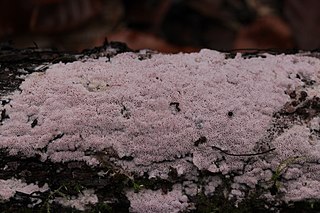Related Research Articles

Skeletocutis is a genus of about 40 species of poroid fungi in the family Polyporaceae. The genus has a cosmopolitan distribution, although most species are found in the Northern Hemisphere. It causes a white rot in a diverse array of woody substrates, and the fruit bodies grow as a crust on the surface of the decaying wood. Sometimes the edges of the crust are turned outward to form rudimentary bracket-like caps.

Skeletocutis amorpha is a species of poroid fungus in the family Polyporaceae, and the type species of the genus Skeletocutis.
Skeletocutis bambusicola is a species of poroid crust fungus in the family Polyporaceae. It was described as new to science in 2012 by mycologists Li-Wei Zhou and Wen-Min Qin. It is found in southern China, where it grows on dead bamboo. The type collection was made in Mengla County, Yunnan Province. The specific epithet bambusicola refers to its growth on bamboo. At the time of publication, S. bambusicola was the 22nd Skeletocutis species recorded from China.
Skeletocutis bicolor is a species of poroid crust fungus in the family Polyporaceae. It is found in Singapore.
Skeletocutis borealis is a rare species of poroid fungus in the family Polyporaceae. Found in northern Europe, it was described as new to science in 1998 by Finnish mycologist Tuomo Niemelä.
Skeletocutis brevispora is a species of poroid crust fungus in the family Polyporaceae. It was described as new to science in 1998 by Finnish mycologist Tuomo Niemelä.
Skeletocutis luteolus is a species of poroid crust fungus in the family Polyporaceae. It is found in southern and eastern China, where it causes white rot.
Atraporiella is a monotypic fungal genus in the family Steccherinaceae. It contains the crust fungus Atraporiella neotropica, known only from Belize.
Fibroporia bohemica is a species of poroid crust fungus in the family Fomitopsidaceae.
Junghuhnia chlamydospora is a species of poroid crust fungus in the family Steccherinaceae. The type specimen was collected in the Cockscomb Basin Wildlife Sanctuary in Belize, growing on a dead standing tree. The crust-like fruit bodies of the fungus measure up to 2 millimetres (0.079 in) thick and have an ochraceous margin. The pore surface is yellowish to discoloured when fresh, later becoming blackish in parts when dry. The angular pores number 2 to 3 per millimetre. The tube layer, which is the same colour as the pore surface, is up to 3 millimetres (0.12 in) deep. Its cylindrical spores measure 4–4.5 by 1.5–2 µm. It has finely encrusted skeletal hyphae, similar to the related Saint Lucian fungus J. carneola. The abundant chlamydospores, for which J. chlamydospora is named, measure 8–12 by 4–6 µm and are strongly dextrinoid. The fungus was described as new to science in 2007 by mycologist Leif Ryvarden.
Skeletocutis azorica is a species of poroid fungus in the family Polyporaceae. It has only been found in Portugal.
Skeletocutis yunnanensis is a species of poroid crust fungus in the family Polyporaceae that was described as a new species in 2016. The type specimen was collected in northern Yunnan Province, southwestern China, where it was found growing on decaying angiosperm wood in a temperate forest.
Skeletocutis subvulgaris is a species of poroid, white rot fungus in the family Polyporaceae. Found in China, it was described as a new species in 1998 by mycologist Yu-Chen Dai. It was named for its resemblance to Skeletocutis vulgaris. The type collection was made in Hongqi District, Jilin Province, where it was found growing on the rotting wood of Korean pine.
Fragiliporia is the sole genus in the fungus family Fragiliporiaceae. It contains the poroid crust fungus Fragiliporia fragilis, described as new to science by Chinese mycologists in 2014. The type specimen of this fungus was discovered growing on a rotting stump of alder in the Gaoligongshan National Nature Reserve in Yunnan. The specific epithet fragilis refers to the brittle fruit bodies of the fungus. Molecular phylogenetics shows that the fungus is in an isolated position in the Polyporales, distinct from the six previously identified clades in this order. In a later study (2017), Fragiliporia was recovered in a phylogenetically isolated position as sister to Candelabrochaete africana.
Butyrea is a genus of two species of crust fungi in the family Steccherinaceae.
Antella niemelaei is a species of poroid crust fungus in the family Steccherinaceae.
Trametes africana is a poroid bracket fungus in the family Polyporaceae. It was described as new to science in 2004 by Norwegian mycologist Leif Ryvarden. It is found in Africa, where it has been recorded from Cameroon, Ethiopia, Kenya, Rwanda and Uganda. The fungus is characterized by its perennial habit and hard woody fruit bodies that become reddish to bay in colour with a waxy surface texture around the base. The pore surface and context are brownish to yellowish. Spores made by the fungus are cylindrical, hyaline, and thin-walled, measuring 5–8 by 2.5–3.3 µm.
Grammothele bambusicola is a poroid crust fungus in the family Polyporaceae that is found in Asia. It was described as new to science in 1984 by Norwegian mycologist Leif Ryvarden.

Ceriporia excelsa is a species of crust fungus in the family Irpicaceae. It is found in Europe and North America, where it typically grows on dead hardwood. It has also been recorded from China.
Skeletocutis niveicolor is a species of poroid crust fungus in the family Polyporaceae. It was first described in 1920 by American mycologist William Alphonso Murrill as Poria niveicolor. The type was collected on well-rotted wood found in Cockpit Country, Jamaica in 1909. Leif Ryvarden transferred it to the genus Skeletocutis in 1985. He noted that it was readily distinguished from other Skeletocutis species by its small spores, which measure 2.5–3.1 by 1.5–2 μm. In addition to Jamaica, the fungus has been also reported from Argentina and Costa Rica.